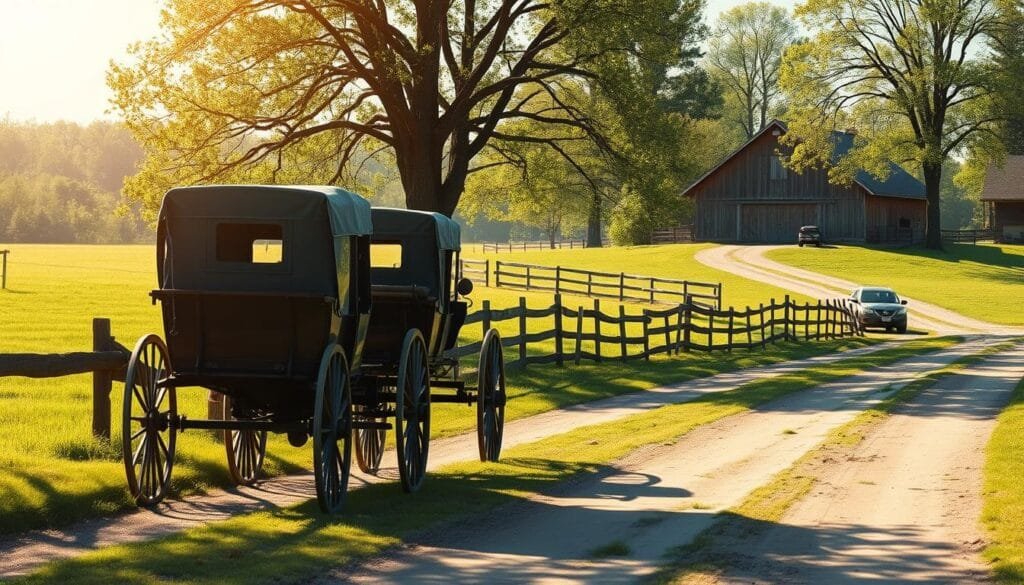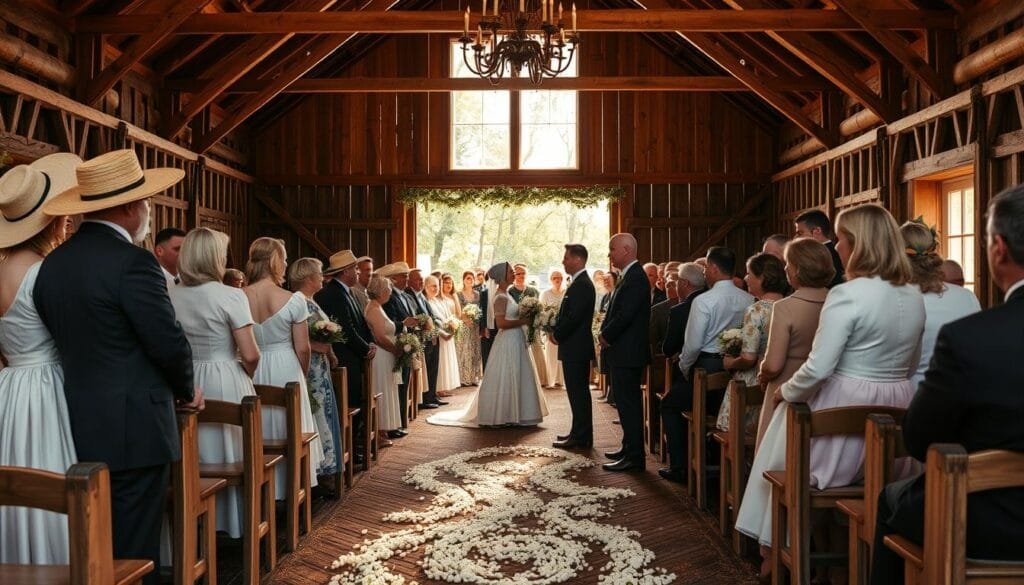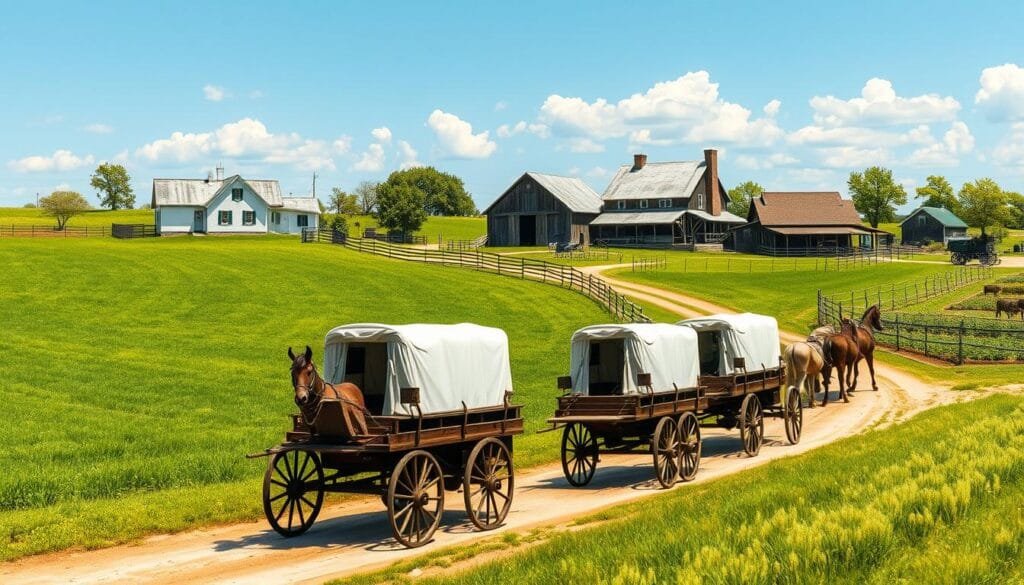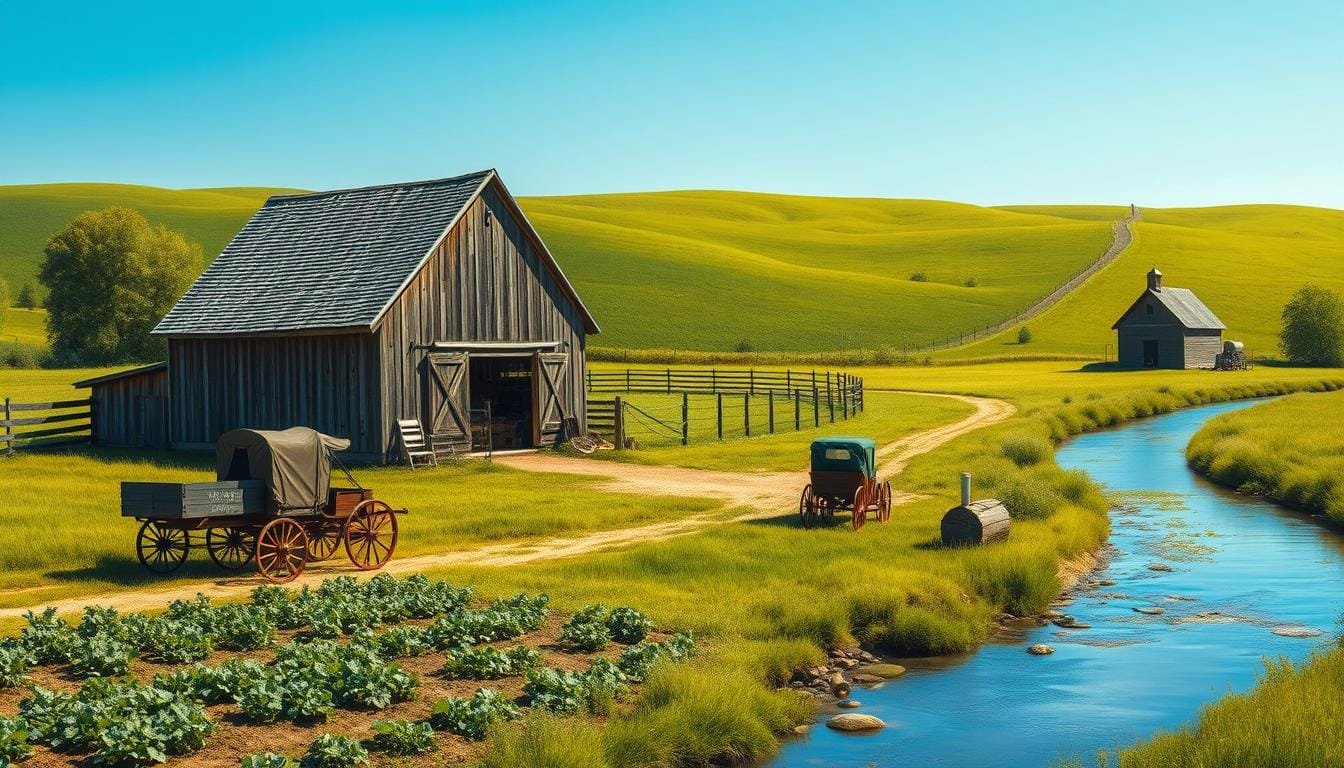Many people are curious about the Amish culture. They often ask if it is mainly a religion or a way of life. The Amish are known for their unique combination of belief and tradition. Their lifestyle and religious practices help preserve old values. These traditions show their deep Amish beliefs.
In the U.S., most Amish live in Pennsylvania, especially in Lancaster County. This area is home to around 43,500 Amish people. They prefer to travel by horse and buggy. Their homes usually do not have electricity or phones. Such customs are key parts of their daily life.
Amish men stand out with their beards and buttoned pants. Amish women wear white head coverings and simple dresses without buttons. This shows their dedication to being modest and simple. Living as Amish means following these customs. It keeps them apart from today’s world.
We will look more into the Amish community. We’ll explore their history, beliefs, way of life, and customs. This will help us see if being Amish is more about faith or lifestyle.
Key Takeaways
- Amish culture intertwines religious beliefs and lifestyle choices.
- Amish communities mostly reside in the United States, with a significant population in Pennsylvania.
- Transportation typically involves horse and buggy, avoiding modern vehicles.
- Amish men and women adhere to specific dress codes reflecting their values.
- The Amish way of life includes minimal use of modern technologies, retaining traditional customs.
The Origins and History of the Amish
The Amish roots reach back to the Protestant Reformation in Europe. Their history is marked by efforts to live differently from modern society. The path from Jakob Ammann’s influence to the birth of Old Order Amish and New Order Amish tells a deep story of faith, migration, and determination.
Jakob Ammann and the Schism
Jakob Ammann, a leader from Switzerland, started the Amish group within the Anabaptist movement in the late 1600s. His strong stance on church rules and cutting off members led to forming the Amish community in 1693. His followers became distinct for their strict biblical practices, marking the start of Amish history.
Migration to North America
Many Amish moved from Europe to North America to escape persecution and poverty, and to find religious freedom. From 1717 to 1750, about 500 Amish sought a new start there. Another 1,500 followed in the mid-19th century. Now, the largest group of Old Order Amish lives in the United States, mainly in Indiana, Ohio, and Pennsylvania. The United States has about 395,000 Old Order Amish, and Canada has over 6,000, mainly in Ontario. For details on their migration and way of life, visit here.
Old Order Amish vs. New Order Amish
The Old and New Order Amish differ in their acceptance of change. The Old Order sticks to traditions and avoids most modern tech. Conversely, the New Order Amish accept some modern conveniences and have a different way of spreading their beliefs. Now, there are about 1,925 Old Order Amish congregations, each practicing their faith uniquely.
Exploring the Amish’s history shows a strong blend of tradition and adaptability. Their dedication to their way of life remains strong in a changing world.
Core Beliefs and Religious Practices
Exploring the Amish community’s core beliefs and religious habits shows us their unique lifestyle. Their life is deeply rooted in humility, faith, and following community rules. This shows the big role religion plays in their everyday life.
Faith and Humility
The Amish faith values humility and living together as a community. They strongly follow the Bible, which guides their everyday decisions. They are quick to forgive, even when accidents happen within the community. The Amish also stay away from modern society, focusing on humility and simple living.
Church Services and Holy Communion
Amish church services show their love for simplicity and togetherness. These services are held in homes every other Sunday for 25-30 families. They sing hymns without any musical instruments or harmony. The leaders include a bishop, deacon, and secretary. During services and Holy Communion, men and women sit separately. Holy Communion happens twice a year and is for baptized members only.
The Ordnung and Community Rules
The Ordnung is crucial for the Amish, setting rules for daily life. It covers dress codes and behaviors that show modesty and humility. Leaders are chosen by lot, which shows their belief in God’s will. Shunning is a last resort for rule breakers, used until they seek forgiveness. The Ordnung varies by area, allowing some local differences yet keeping overall unity.
Amish Lifestyle and Daily Life
The Amish way of life centers on simplicity, community, and tradition. They live differently, from their clothes to their schools. This shows their values and lifestyle.
Plain Clothing and Modesty
Amish clothes are simple to avoid vanity and keep humility. Men wear trousers with suspenders and no belts, and they grow beards when married. Women choose modest dresses and bonnets, showing if they’re married. Their clothes use hook-and-eye fasteners and pins instead of modern buttons or zippers.
Transportation and Technology Restrictions
The Amish use horse-drawn buggies, not modern cars. This choice supports their simple life values. They follow the Ordnung, limiting tech use. This promotes community life and traditional ways over new technologies.

Barn Raising and Community Support
Barn raising shows Amish community strength. Families unite to build barns, key for their farming. These events bond the community, showing support and solidarity.
In Northern Indiana, most Amish men work in factories or as artisans. Yet, they still come together for barn raisings, keeping their community ties strong.
Education and Schooling
Amish schooling readies children for their community life. They stop formal school after eighth grade. Then, boys start apprenticeships while girls learn about running a home. The curriculum focuses on practical skills and moral lessons, not just academics. This approach fits with their values of humble and self-reliant living. Amish children learn important life skills despite the short formal education period.
Below is a brief comparison highlighting key aspects of Amish daily life:
| Aspect | Description |
|---|---|
| Amish Clothing | Plain designs, hook-and-eye closures, suspenders for men, bonnets for women |
| Amish Transportation | Horse-drawn buggies, prohibition of modern vehicles |
| Amish Education | Ends at eighth grade, apprenticeship for boys, household skills for girls |
| Community Support | Barn raisings, mutual cooperation and assistance |
All these parts of Amish life show their deep values. They value simplicity, community, and keeping traditions in everything they do.
Amish Weddings: Tradition and Celebration
Amish weddings are deeply rooted in community, hard work, and traditions. They showcase the essence of Amish culture, which values faith and tradition.
Wedding Season and Announcements
Most Amish weddings occur in late fall, around November or December. Some choose spring instead. The engagements aren’t publicly announced. The wedding date is shared just weeks before, keeping things private. This avoids attracting too much attention.
Weddings are on Tuesdays or Thursdays. This ensures that clean-up doesn’t interfere with Sunday church services.

The Wedding Service and Feast
The bride’s home hosts the wedding service, drawing 200 to 400 guests. This includes family, friends, and church members. The service starts early, at 4 AM, and lasts three hours. It emphasizes Amish marriage traditions.
A big feast follows the service. Guests often eat twice to ensure everyone is fed. The menu symbolizes Amish warmth. It features fried chicken, mashed potatoes with gravy, pies, and creamed celery. A special table, the “eck,” is for the newlyweds, marking their union. Learn more about Amish wedding traditions here.
Life of the Newlyweds
The couple spends their wedding night at the bride’s house. Their honeymoon is unique. It includes visiting relatives and friends during winter weekends. During these visits, they get practical wedding gifts like dishware, canned food, and tools. These gifts help start their new life together. Amish weddings and their traditions show deep respect for family and community bonds.
Is Amish a Religion or a Lifestyle?
The Amish blend their faith, culture, and daily life. It’s hard to separate their lifestyle from their religious practices. Their culture is rooted in their beliefs, shaping every part of their lives and community.
Founded by Jakob Ammann in the 17th century, the Amish religion follows Anabaptist and Protestant beliefs. Key principles include choosing baptism, living peacefully, and avoiding modern society’s influences. These ideas lead to a simple, humble, and community-focused way of life.

Amish values show in their culture. For example, their plain dress code rejects vanity. Through such choices, they stress their values over material wealth.
The Amish value simplicity and working together, seen in barn raisings. These events display community support, with men building and women cooking. It connects their activities with their religious beliefs. They also favor big families, which shows the importance of family and community to them.
Amish education mixes religion with lifestyle too. Their schools encourage teamwork and practical skills for farming and crafts. This reflects their religious values of humility and diligence, emphasizing their unique identity.
Amish also carefully choose what technology they use, due to religious beliefs. Elders decide if something like electricity fits with their values. This cautious approach helps them maintain a focus on love, family, and modesty.
Conclusion
As we explore the Amish way of life, we find a community with deep roots. It is built on strict traditions and a strong sense of togetherness. To understand the Amish, we must look into their history, beliefs, and daily customs. They have created a distinct culture since Jakob Ammann’s time and the move to North America. Today, there are about 350,000 Amish people living in over 535 communities.
The Amish value simplicity, modesty, and community bonds. They follow the Ordnung, which are rules guiding their life. This includes special clothing, using less technology, and working in traditional ways. Their schools teach until age 14, focusing on life skills for community life. Despite schooling ending early, most Amish youth choose to stay and fully join the community after Rumspringa.
Looking closely at the Amish shows us a society that values independence but sticks together through faith and tradition. They’re growing fast, with their numbers doubling every 20 years. The Amish are a living example of the strength of community and holding onto one’s heritage. Their dedication to their lifestyle, from their language to their daily tasks, reveals how they manage to keep their beliefs while navigating the modern world.
FAQ
What are the core beliefs of the Amish?
The Amish live by values of humility, simplicity, and faith. They follow a Christian doctrine that highlights community and Jesus’ teachings. Their family life is very important to them.
Their daily living and religious practices are guided by the Ordnung. This is a set of unwritten rules.
How do Amish people live without modern technology?
Amish communities avoid most modern technology. They prefer horse and buggy over cars and use simple farming tools. This choice helps them live simpler lives.
They generally avoid electricity to stay away from worldly temptations. Some may use generators and battery-powered devices for basic needs.
What is the Ordnung?
The Ordnung is a collection of guidelines for the Amish. It dictates their daily activities, clothing, and technology use. It helps them keep their traditions and values.
Each Amish district has its own specific Ordnung. The community members agree on these rules.
How are Amish weddings different from typical American weddings?
Amish weddings focus on simplicity and community. They are held in the fall and include a big feast for the community. The ceremonies are filled with religious rituals.
The newlyweds usually settle near their families. This supports community unity and support.
Who was Jakob Ammann?
Jakob Ammann was a leader who started the Amish movement in the late 1600s. He valued strict discipline and introduced shunning to the faith. This caused a split from the Mennonites, creating the Amish church.
Why did the Amish migrate to North America?
The Amish moved to North America in the 1700s to escape persecution and find good farming land. Pennsylvania was appealing for its religious freedom and land prices. This migration helped them keep their way of living and beliefs intact.
What is the difference between the Old Order Amish and the New Order Amish?
The Old Order Amish stick closely to their traditional beliefs and practices. They follow the Ordnung strictly. On the other hand, the New Order Amish are more open to some modern ideas. They allow limited electricity and Sunday school for kids.
Despite differences, both groups value faith, community, and simplicity above all.
